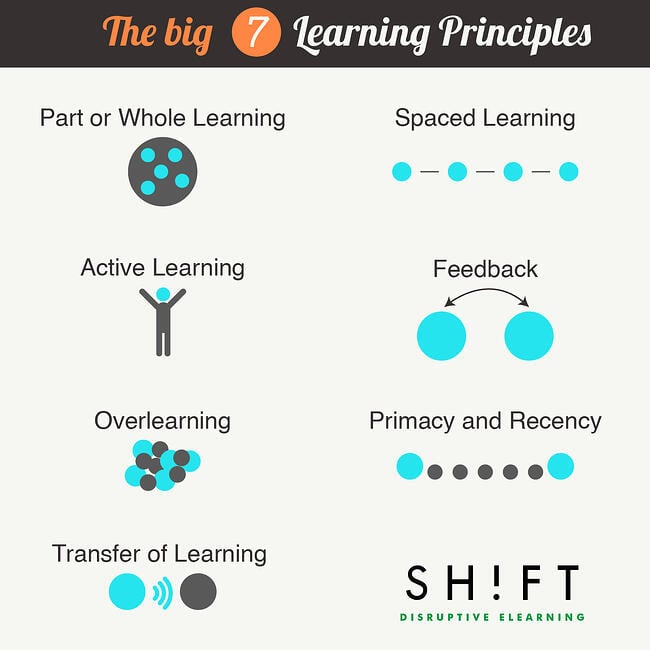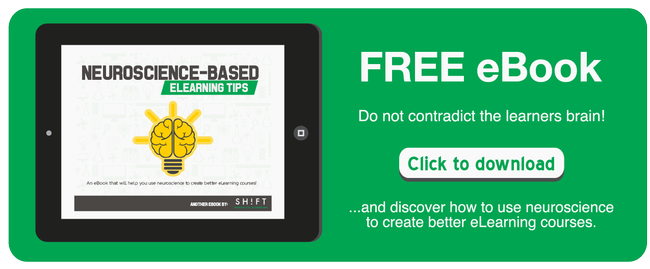There are principles of good learning design and delivery every training professional should be aware of. These are not mere abstractions but rather serve as a practical guide in planning effective online training programs. In fact, Geri E. McArdle, in his book Training Design and Delivery, encourages training professionals to become familiar with these and apply them later. Basically, if they understand these principles and weave them into their training, they'll create more effective online learning experiences.

1. Part or Whole Learning
It's not a question of which is more superior: part-learning or whole-learning segments. Rather, it is a question of what works best depending on the nature of the task and the trainee.
In part learning, the training material is practiced one part at a time. The skill or knowledge is segmented into several parts. Whole learning is the exact opposite. It essentially considers the skill or knowledge to be transferred as a large, unified block of material. Thus all of the training material is practice at one time.
Consider whole learning when designing eLearning for simple skills that cannot be separated into several parts. In fact, experts agree that the whole method of learning works best when preceded by the part method.
As for part learning, make sure that each part or segment of training isn't too large. More importantly, parts should be logically arranged in sequence. It should enable learners to smoothly flow from the known to the unknown—that is, eventually understand the information. Be careful; training professinoals are often tempted to oversimplify when employing this method.
2. Spaced Learning
In contrast to crammed learning, spaced learning takes place over an extended period of time. The latter is definitely superior to crammed learning because the brain needs ample time to take in and fully understand new facts before it can accept the next group of information.
Space learning, without a doubt, helps learners retain new material longer. At the core of it is the belief that real learning doesn't usually happen in one-time events—that it takes place over time.
Take advantage of it but be sure that the spacing interval isn't too wide or is equal to the retention interval.
Quick Read: Why Spaced Learning Works Better Than Cramming
3. Active Learning
This principle is often described as “learning by doing.” Here, the learner is given plenty of opportunities or instances to practice the skill or apply the new information. Their active involvement in their own learning allows for internalization and encourages them to become self-motivated. It, in turn, enables them to absorb new material more quickly and effectively.
In short, the key lies in promoting productive mental activity during learning. Ruth Colvin Clark and Robin E. Meyer couldn't have said it better "physical activity does not equate to mental activity, and it is mental, not behavioral, activity that leads to learning". For example, ask thought-provoking questions, including distributed exercises and providing plenty of practical work to keep learners actively involved in the process.
Recommended: Active Learning Explained (visually).
4. Feedback
Feedback is crucial in motivating learners and ensuring the efficiency of their learning process. When provided with feedback, learners usually try to correct mistakes and eliminate errors accordingly.
Note, however, that the best feedback is given immediately. It should also reinforce learning and sustain a trainee's interest and motivation—the kind usually referred to as positive feedback. The latter can be in a form of a simple explanation on why an answer is correct or incorrect or a much more complex form like when the teacher discusses the results of a test.
Check out this SlideShare presentation: 7 Characteristics of Positive Feedback in eLearning
5. Overlearning
Think learning is enough? Well, cognitive science disagrees. Researchers found that in order to perform a task well, we need to overlearn it—not just learn it.
The key here is to practice beyond the point of mastery, or familiarity. Help trainees keep on practicing by asking frequent questions and providing exercises to recall previous learning.
Practicing, however, is just the beginning according to researchers at the integrative physiology department at the University of Colorado-Boulder. The aim is to perform better, with less mental effort.
Quick Read: The Science of Smart: Don’t just learn—overlearn
6. Primacy and Recency
The principles of primacy and recency states that, given a sequence of information, learners tend to remember what they heard first and last, but often tend to forget what they heard in the middle.
To remedy this, training managers are highly recommended to reinforce facts in the middle and, and the same time, present crucial information at start or end of the training session. You can also teach new material first and practice or apply it during down time. Varying the type of task, the instructional method, and even subject during peak periods are equally effective techniques.
Use primacy and recency effectively by following these tips by The Zen of Learning:
- Put the most important content either at the beginning or the end of your course, module or screen.
- If you organize your content in form of lists, make sure that all the key stuff is either at the top or at the bottom.
- Break your longer lists into two or more columns. The learner’s mind will then perceive each list as a separate one and the Primacy Effect will help him/her remember more.
7. Transfer of Learning
You might have heard of this several times before. It simply refers to learning in one context and applying it in another. When trained for a specific skill or knowledge, for instance, a learner has to be able to apply it across a variety of tasks. Only then can a transfer of learning occur.
This principle has attracted more and more attention in the previous years that researchers have referred to it in different names: life-long learning, knowledge transfer, multitask learning, inductive transfer and learning to learn.
While you as a training professional are not wholly responsible for the lack of learning transfer, you are in unique position to help learners make the most out of their lessons. Remember, it’s not about what people know—it's about what they can do with what they know.
Quick Read: How to Increase Learning Transfer
Recommended Book (and read a free chapter here): Making eLearning Stick: Techniques for Easy and Effective Transfer of Technology-Supported Training









